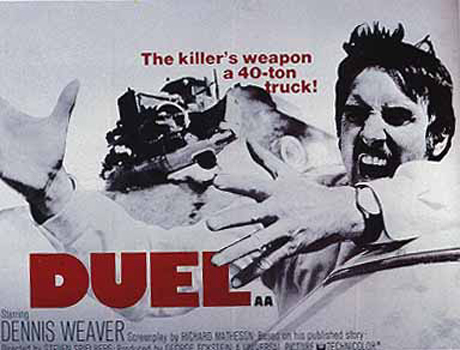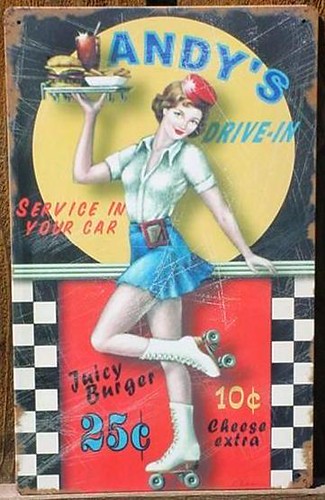DUEL!
The Valiant Little Plymouth
By: Mike Marino

The forces of good versus evil have duked it out on the stage of human drama and comedy for daily performances and matinees since the Garden of Eden lost it's virginity. A toples lady and an apple will do it everytime. Enter stage left. The 1960's. Social upheaval erupted like an angry volcano, lava tearing away the vegatation, exposing the nasty little secret that the world is filled with hypocripsy and violence. Nothing a little a dope and music wouldn't cure, we concluded. There was no sense to the nonsense, we surmissed, and noticed a schizophrenic duality to human condition that raised the question, "Just who are the bad guys anyway"? A tough pop quiz question for the times, but Professor Steven Spielberg had the answer with the release in 1971 of his cult masterpiece, "Duel". Starring Dennis Weaver, as David Mann, a traveling salesman with giant steroid fed aviator sunglasses who tries in vain and in a pool of sweat to outrun and outwit an 18 wheel diesel powered Headless Horseman. It's a celluloid David Mann monologue backed up by a steady concerto of heavy metal chase scenes that pits a hungry, perhaps carnivorous meat and metal eating 1955 Peterbilt truck against, of all things, a 1971 slant six, orange-red, four door sedan...a Plymouth Valiant. Now, we know who the bad guy is! Class dismissed!
1964 V-8 Valiant

Faceless, motiveless, the big rig pitbull hunts our hapless hero up and down the asphalt trail. Climbing uphill, the valiant little Valiant is loosing power, big time. The radiator, now redhot, begins to overheat, needle racing into the dreaded redzone as David Mann sweats drops as big as Buicks, panic etched into his face he looks in the rearview. The truck is noticeably absent, he enjoys an inward chuckle as a sense of momentary relief overcomes him, cool and crisp even in the sweltering heat of the California day. A deep sigh and a slight twinge of joy. It's over! It's over! Then the evil twins of dread and terror return as the truck reappears and begins to round the bend, gaining speed and closing the gap. An emotional dagger thrusts itself deep into Davids soul, slicing like a Ginsu clear through to his fragile pysche, reaching raw bone, as he falls screaming silently further into the depths of his own personal asphaltian hell His fears, dancing a macabre dance of death in the shimmering mirage in the road ahead, as he finally realizes..Objects in the rearview mirror really are closer than they appear. David has finally met Goliath, and now Goliath must fall.
'Duel' originally aired on network television in 1971 as a Saturday Night Movie. The original film was only 74 minutes long and was rated extremely high on the critics Richter scale. Not bad for a 23 year old directors debut! Following 'Duel's successful TV airing, Universal released the made for tv flick overseas in 1973 as a theatrical release. Short by film standards it was determined that 74 minutes was not long enough for moviegoers so two days were spent adding several new scenes which expanded the movie into a bonafide 90 minute film. Added scenes included the railroad crossing, the stuck in the dirt school bus, and David telephone call to his wife. Add a pinch of profanity and voila! Instant movie for the movie going masses.
The Plymouth Valiant is the kissing cousin to the Dodge Dart, and why Spielberg chose a 1971 Valiant to be the automotive anti-hero to the Peterbilt diesel anti-Christ in this superb thriller is summed up best by Spielberg himself. In an interview he stated that the underpowered car versus the overpowered truck exemplifies humankinds daily struggle against things much larger than we. The spunky Valiant line outraced monster killer trucks from it's introduction in 1959, although it was introduced as a 1960 model until it ran out of fiscal fuel in the Bicentennial year of 1976. It actually outsold, if you can believe it, the powerful Plymouth Fury in it's virgin voyage of sales. The powertrain was a 170 cid slant six with a single barrel carburetor. There were suburban stationwagons along with the standard mom and pop four door models. In 1961, sporty two door models began to freebird it off the assemblylines and wind in the hair convertibles hit the asphalt running in 1963. Car colors were important in those days, unlike the bland nameless colors of today's mo'sheens. There was the light blue, light green, blue, green, black, white, red, and yes, even silver! As 1976 rolled around the Valiant ran out of steam and the brain trust at Chrysler replaced the line with Volares and Aspens.
The car certainly lived up to it's Valiant name in this conflict flick of the 1970's that was stretched tighter than a polyester leisure suit that was two sizes too small on a fat man. In the tv version they only had one truck so the final shot of the truck falling off the cliff had to be completed in one take. The theatrical release had to use additional trucks that were purchased in order to film the additional scenes required. Only one of the trucks has surivived today. At the films end all the wreckage was removed and scrapped in 1971. If yu want to travel the road best not taken by David Mann you can visit where the final crash was filmed in Agua Dulce Canyon in Arizona. All the driving sequences were filmed on the Sierra Highway, Soledad Canyon Road, Agua Dulce Canyon Road, and Indian Canyon Road. Chuck's Cafe is still there but it now serves up French cuisine. So what ever happened to the hellcat Valiant? All the Plymouth Valiants in the film were destroyed during the filming. The correlation between Spielbergs "Duel" and "Jaws" were also addressed in an interview with the director. The dinosaur roar sound effect that is heard as the truck goes over the cliff is also heard in Jaws as the shark's carcass sinks into the ocean. Spielberg said that this is because he feels there is a link between Duel and Jaws, as "they are both about leviathans targeting everyman." Spielberg also said that by including the sound effect into Jaws was "my way of thanking Duel for giving me a career."
The Sixites were a confusing time, and the Seventies sought to untangle the tie-dyed mess that was created, and in the process gave us a wonderful film and cheap sunglasses along with a most valiant Plymouth that could hold it's own against diesel evil incarnate.
"We've got to get a bigger boat!"



Classic Cars, Rock n' Roll, Elvis, Drivein Movies & Route 66! Kerouac, The Beats, Haight Ashbury, Easy Rider & Vietnam!

The Roadhead Chronicles goes from the Cold War Fifties Pop Culture of classic cars and rock n' roll to the spaced out Spare Change Sixties of Vietnam and Hells Angels. Not the usual look at the era, instead It's written by someone who lived it and spent a life of being on the road from his beach bum days in Honolulu to the glitz and dangers of the Sunset Strip in LA, and his purple hazed and double dazed days in North Beach and the Haight Ashbury in San Francisco. The Roadhead Chronicles also looks at the history of Route 66, Roadside Neon Culture and old diners and dives!

Mike Marino writes in an offbeat and irreverant style with a beat and a cadence that is all his own. His writing style has been compared to John Dos Passos, John Steinbeck and Terry Southern and one reviewer likened him to Frederick Lewis Allen on acid! Readers and critics call the book "wickedly wonderful", "delightfully weird" and "automotively sexy."!!
